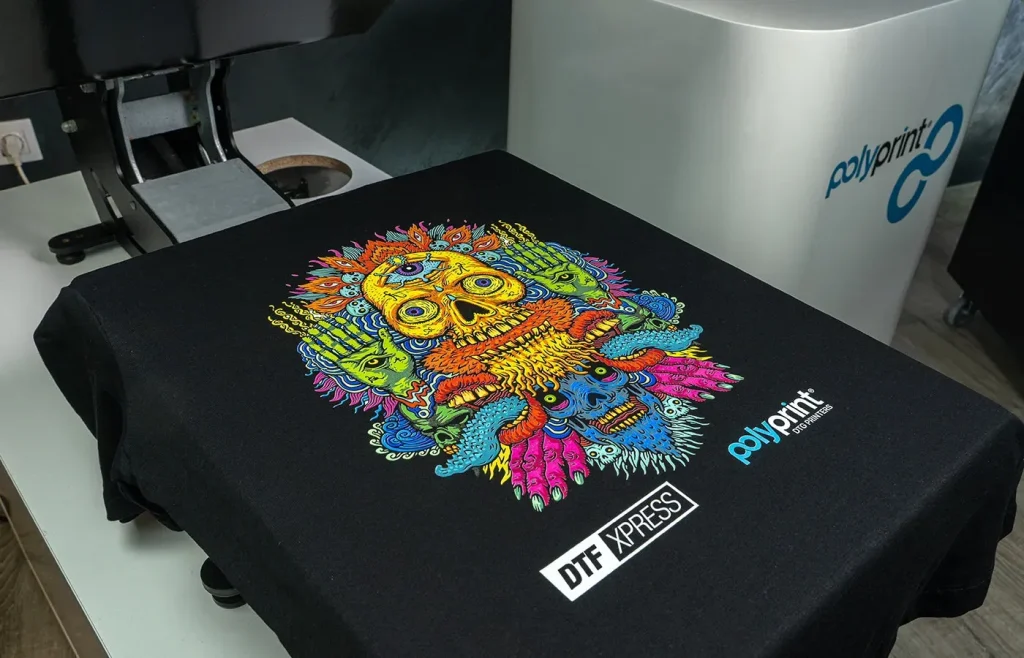In the ever-evolving world of custom apparel, DTF printing, or Direct-to-Film printing, is making a significant impact. Unlike traditional printing methods such as screen printing or direct-to-garment (DTG), DTF utilizes a unique transfer film to ensure vibrant and intricate designs that stand out. This innovative printing technology not only enhances color accuracy but also provides versatility across different fabric types, making it an appealing choice for businesses of all sizes. As brands seek to meet the demands for high-quality, customized items quickly, DTF printing emerges as a frontrunner, bridging the gap between efficiency and creativity. By understanding DTF alongside other printing technologies, businesses can make informed choices that best suit their needs.
When discussing modern printing options, one may encounter terms such as Direct-to-Film (DTF) printing, transfer printing, or even film-based garment printing. These alternative descriptors highlight the advancements in printing technology that cater to the custom apparel niche. Unlike classic methods like screen printing, which relies on stencils, or direct-to-garment (DTG) printing, known for its inkjet application directly onto fabric, DTF presents a unique solution that combines vibrant detail with operational flexibility. With a focus on deliverability and quality, businesses can harness the benefits of DTF while navigating the intricacies of the traditional printing landscape. Understanding these terms enriches the conversation around custom printing, emphasizing the transformative effects of emerging technologies.
Understanding the Benefits of DTF Printing for Custom Apparel
DTF printing, or Direct-to-Film printing, stands out in the custom apparel market due to its ability to produce vivid, high-quality images with intricate details. This technology utilizes a specially designed transfer film, allowing for seamless application to various textile materials. Unlike traditional screen printing, which can sacrifice detail for speed or cost, DTF consistently delivers stunning results across a range of fabric types. Brands looking to create visually striking designs, whether on cotton or polyester blends, often turn to DTF printing to fulfill their creative visions.
The adaptability of DTF printing is another substantial advantage for custom apparel businesses. As consumer preferences shift towards more personalized designs, DTF offers flexibility that traditional methods may lack. Smaller businesses, in particular, benefit from DTF’s low minimum order requirements. With DTF, entrepreneurs can fill orders quickly and efficiently without being burdened by high setup costs typically associated with traditional screen printing. This ability to cater to shorter runs while maintaining high quality makes DTF printing a game-changer in the custom apparel industry.
Cost Analysis: DTF Printing vs. Traditional Methods
When evaluating the cost-effectiveness of DTF printing compared to traditional printing methods such as screen printing and direct-to-garment (DTG), several factors come into play. While screen printing may be more affordable for large batches, DTF proves advantageous for smaller custom orders because it eliminates the need for extensive setup costs. This aspect allows businesses, particularly those catering to niche markets, to remain agile and responsive to demand fluctuations.
Moreover, DTF printing technology allows for bulk savings in terms of materials. Unlike traditional methods, which often waste ink and fabric due to the nature of stenciling and setup, DTF optimally utilizes resources, further lowering overall printing costs. For business owners wanting to optimize their budgets while maintaining high-quality production, opting for DTF can lead to substantial savings, making this newer printing technology financially appealing.
Quality and Detail: DTF vs. Screen Printing
Quality and detail are paramount in custom apparel printing, and DTF printing shines in this area compared to traditional screen printing. DTF technology excels in reproducing vibrant colors and fine design elements without sacrificing clarity. Screen printing often struggles with gradients or complex images, leading to a duller finish or blurring, especially when printing smaller designs. For brands prioritizing the fidelity of their artwork, DTF provides a reliable option that upholds design integrity without compromising on quality.
Additionally, DTF printing allows for detailed replication of intricate logos and patterns, a feat that traditional methods can find challenging. As fashion and branding evolve towards more complexity, DTF meets that demand head-on, enabling businesses to offer unique and customizable designs that resonate with their customer base. By leveraging DTF technology, brands can ensure that every piece reflects their identity, ultimately resulting in enhanced customer satisfaction and loyalty.
Material Versatility: Why DTF is the Superior Choice
Material versatility is another critical factor that highlights DTF printing’s advantages over traditional techniques. While screen printing is predominantly suited for cotton fabrics, DTF can effortlessly adhere to various materials, including polyester, blends, and even some synthetics. This flexibility means that businesses can expand their product offerings without being limited by the types of fabrics they choose to use.
In today’s apparel market, where mixed-material garments are becoming increasingly popular, the ability to print on diverse substrates without compromising quality becomes essential. DTF’s compatibility with different textiles empowers brands to experiment with unique fabric combinations, enhancing their creative range and product appeal. This adaptability positions DTF as a forward-thinking solution tailored to meet the evolving demands of modern fashion.
Production Speed: Streamlining Your Custom Apparel Orders with DTF
As businesses strive for efficiency in the fast-paced world of custom apparel, production speed becomes a decisive factor in choosing the right printing method. DTF printing significantly reduces production times compared to traditional methods, enabling quicker turnaround for small orders. In an industry where customer satisfaction revolves around prompt delivery, the efficiency of DTF technology can be a competitive edge for businesses aiming to satisfy consumer demand.
Moreover, DTF allows for the simultaneous printing of multiple designs on various garments, streamlining the workflow further. This capability is particularly beneficial for brands handling a wide range of custom orders, as it minimizes downtime and accelerates overall production. Businesses can capitalize on the speed and efficiency provided by DTF printing to fulfill orders faster, ultimately enhancing their operational workflow and ensuring they stay ahead in a competitive landscape.
Choosing the Right Printing Method: DTF or Traditional?
Deciding between DTF printing and traditional methods like screen printing or direct-to-garment printing hinges on several critical factors including order size, design complexity, and material choice. Businesses that frequently handle larger orders may still find traditional methods advantageous, especially when dealing with simpler designs. However, as consumers increasingly desire personalized items, DTF offers a more suitable solution that adapts to varying order sizes and design intricacies.
When evaluating the right printing method, it’s essential to consider your target audience’s demands and your brand’s operational capabilities. For smaller businesses focusing on varied designs and unique materials, DTF presents a viable and efficient option. On the other hand, those with consistent large-order requests may still leverage traditional printing techniques. Ultimately, understanding these nuances will allow businesses to align their printing choices with their growth strategies.
Frequently Asked Questions
What are the main advantages of DTF printing compared to traditional printing methods?
DTF printing offers several advantages over traditional printing methods such as screen printing and direct-to-garment (DTG) printing. It is more cost-effective for smaller orders due to lower setup fees, produces vibrant colors and intricate designs without loss of detail, and has a broader fabric compatibility, allowing it to work seamlessly on various materials like cotton and polyester. Moreover, DTF printing boasts faster production times, making it ideal for businesses needing quick turnaround on custom apparel.
Is DTF printing suitable for larger production runs compared to traditional screen printing?
While traditional screen printing is often the go-to for large production runs due to its efficiency in applying ink in bulk, DTF printing can also be suitable for larger orders depending on the design complexity. However, for simple designs on larger quantities, traditional methods may still offer cost advantages. Companies should evaluate their order sizes and design needs to choose the most appropriate printing technology for their production runs.
Can DTF printing produce intricate designs better than direct-to-garment printing?
Yes, DTF printing excels at producing intricate designs with fine details compared to direct-to-garment (DTG) printing. DTF technology utilizes high-quality transfer films that capture vivid colors and sharp imagery, overcoming some limitations faced by traditional methods. Therefore, if your custom apparel requires complex graphics, DTF printing is an excellent choice.
What types of fabrics can DTF printing be used on compared to traditional printing methods?
DTF printing is highly versatile and can be applied to a wider variety of fabrics compared to traditional printing methods like screen printing. DTF can adhere to cotton, polyester, blends, and even some synthetic fabrics, offering more options for custom apparel. In contrast, screen printing has limitations with certain fabric types, which makes DTF a preferred choice for brands targeting diverse material uses.
How does DTF printing affect production time for custom apparel orders?
DTF printing generally provides reduced production times, especially for smaller custom apparel orders. Its simplified process allows businesses to fulfill orders quickly without extensive setup, making it ideal in a market where speed is essential. In comparison, traditional printing methods may involve more complex setups and longer processing times.
What should businesses consider when choosing between DTF printing and traditional printing methods?
When choosing between DTF printing and traditional printing methods like screen printing or direct-to-garment printing, businesses should consider factors such as order size, design complexity, and material types. DTF is best for varied and smaller orders with complex designs, while traditional methods may be advantageous for larger runs with simpler graphics. Evaluating these aspects will help businesses make an informed decision that aligns with their custom apparel needs.
| Factor | DTF Printing | Traditional Printing |
|---|---|---|
| Cost-Effectiveness | Generally more economical for small runs. | Higher setup costs make it less viable for small orders. |
| Quality and Detail | Produces vibrant colors and intricate designs without resolution loss. | Can struggle with detail in complex designs. |
| Versatility of Materials | Works well on a wide range of fabrics including cotton, polyester, and blends. | Limited ability on synthetic fabrics. |
| Production Time | Reduced production times, particularly for smaller orders. | Can be slower and cumbersome, especially for varied designs. |
| Best For | Small to medium-sized orders with complex designs. | Large orders with simpler designs. |
Summary
DTF Printing is transforming the custom apparel landscape by offering businesses innovative solutions that cater to their unique needs. As companies navigate the decision between Direct-to-Film (DTF) and traditional printing methods, understanding the benefits such as cost-effectiveness, superior quality, versatility in fabric options, and faster production times is essential. DTF presents a cutting-edge approach ideal for small to medium-sized orders and complex designs, making it a compelling option for brands aiming for intricate details and vibrant outcomes. Ultimately, the choice between DTF and traditional methods should be based on specific business requirements, ensuring optimal results for customer satisfaction and productivity.



